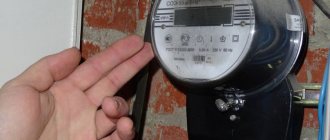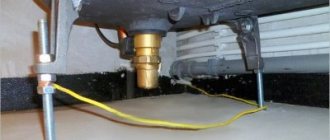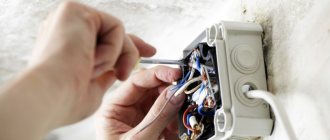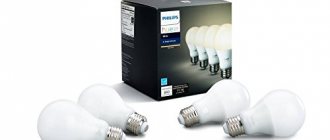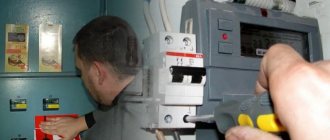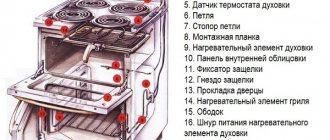Burnt wire smell? Causes and how to eliminate
Electrical wiring always gets hot in the weakest place, where there is no reliable contact or a thin wire.
For example, a low-quality extension cord plug can melt and even burst into flames under significant load. Inexpensive extension cords, which seem to be of very high quality (thick wire, high-quality cast plug), may turn out to be complete junk in reality; the manufacturer has saved on the wire cross-section. Thus, an extension cord designed for a current of 10 amperes will withstand one heater with a power of up to 2.2 kilowatts. If you turn on a large load, the wire or plug of such an extension cord will begin to heat up and the smell of burnt electrical wiring will appear.
When buying an extension cord, pay attention to the permissible (rated) current. The appearance and thickness of the wire say little about the reliability of the extension cord.
Poor quality electrical fittings
A socket, switch, or circuit breaker in an electrical panel can cause the smell of burnt wiring . In case of poor assembly and poor contact, it can catch fire in a very unexpected place. For example, in a seemingly reliable socket, the screws were not tightened during assembly. Such an outlet can work without problems for years, but if you turn on the heater in it, heating will occur in a weak spot, and the smell of burnt plastic will appear.
When buying a socket or switch, pay attention to the permissible (rated) current; the higher the value, the more reliable. Preference for sockets and switches made in Germany. Ceramic electrical fittings are much more reliable than plastic ones.
Overload in the electrical network
Appliances are becoming more economical, but some electrical appliances, such as:
They are powerful consumers of electricity and require special attention. A seemingly small flow-through heater that is installed under the sink can “eat” up to 30 kilowatts! Such electrical appliances must be connected separately, through your own machine and your own, more powerful wiring. If you plug the instantaneous heater into a regular outlet, you can easily overload the wiring and you will smell the heating wiring.
What to do if you smell burning wiring?
Turn off power to all powerful electrical appliances in the apartment, irons, hair dryers, heaters, washing machine or dishwasher, in short, everything that heats. It is best to turn off the circuit breakers in the electrical panel.
Try to localize where the smell of burnt wiring is coming from. Check the extension cords (especially long ones, more than 3m); if you overload the extension cord, it will get hot and smell like burnt wire.
Based on indirect evidence, we determine the weak link and, if possible, fix it ourselves, but if the breakdown is significant, CALL AN ELECTRICIAN!
Here, too, options are possible, if the wire is lit up to the electric meter, the so-called input - you can invite an electrician from the management company or emergency crew . If there is a breakdown after the meter, then you need to call our electrician, for example.
In any case, if the wiring smells, it is dangerous to turn on powerful consumers (electric stove, air heater, hair dryer, microwave) until the accident is eliminated! Light, computer, TV at your discretion...
Video from experts about the smell of burnt wiring
As a result of the negligent work of the electrician, the power wire was secured with nails. It’s just pierced right through with nails, it’s fucked up - such a woe = an electrician needs to have his arms amputated.
What key is needed for the floor electrical panel
To inspect your electrical wiring at the input, you need to gain access to the floor electrical panel, which is usually locked. One can only guess what the key to the electrical panel looks like and where to get it. As a rule, two types of keys are used for electrical panels, see photo:
key for floor electrical panel
Source
What to do if the connection device catches fire
What to do if an outlet catches fire is a question that everyone should know the answer to. In a moment of danger, it is easy to get confused, but urgent and adequate actions are needed. The cause of a sudden fire may be incorrect installation of the connection device, breakdowns inside the mechanism, as well as incorrect operation of the product.
How to extinguish an electrical outlet fire
Due to a malfunction or short circuit, the socket caught fire, what should people who are in this room do? Remember. You can extinguish a connection point that is energized using special fire extinguishers:
- carbon dioxide;
- powder;
- chemical foam (air emulsion).
Attention! When using a carbon dioxide fire extinguisher, do not touch the metal parts of the device with bare hands. A decrease in carbon dioxide pressure causes a sharp drop in temperature, and therefore threatens a person with frostbite on his hands.
Dry earth and sand will replace the special agent, but will be less effective; try to put out the flame by covering it with a piece of dense natural textile. Do not use water under any circumstances; it is dangerous when extinguishing electrical appliances.
Don't have the type of fire extinguishers you need nearby? Then proceed according to the following algorithm:
- Assess the scale of the incident. If smoke or sparks appear in the area of the outlet, turn off the electrical appliance as quickly as possible. Under no circumstances should you grab the electrical cord or wires directly with your hands.
- If you are in a familiar room and know where the electrical panel is located, turn off the electrical power - unscrew the plugs or turn off the switch.
- If you are in an unfamiliar room, you should interrupt the power supply to the device in a dangerous place. Use pliers with rubber handles or cut the wire with an ax with a dry wooden handle.
Be sure to call an electrician, describing everything that happened at the scene.
What to do if the socket is on fire and the fire and smoke spread quickly? Do not try to isolate such a problem yourself. Quickly take the documents and leave the premises along with other residents of the house/office employees. After urgently calling a special service, wait for the fire brigade to arrive.
The apartment smells like wiring, what should I do?
Sometimes there are situations when you can smell burning wiring in the room. As a rule, this happens in old houses where the wiring is old, but modern buildings are not immune from this, because electrical installation can be done incorrectly or using low-quality conductors. If you hear a smell, you need to immediately take action; you can’t hesitate - a fire may happen. In this article we will tell you what if there is a smell from the wiring in your apartment, where to call and how to quickly fix the problem.
Sewage smell in the entrance: where to go?
In the event of a new refusal, it makes sense to appeal it in court. At this stage, you may need the help of a lawyer. In exceptional cases, the violator may not only pay a fine, but also lose his apartment. (Samples compiled by the National Legal Service.) In order to competently defend your rights, you need to clearly understand that our legislation does not answer the question of how many animals you can keep in your apartment. The legislator divided animals into wild and domestic. The tasks of protecting wild animals, the species of which are listed in the Red Book, are regulated by law, and the Civil Code classifies domestic animals as property (Article 137 of the Civil Code of the Russian Federation). It is possible to keep pets in an apartment building, the main thing is not to violate the rights and legitimate interests of neighbors
ATTENTION! If, after contacting Rospotrebnadzor, housing and communal services or management company specialists nevertheless went to the address of the leak and fixed it, you need to inform the last point of the complaint. You can also attach to the application to the court evidence of damage to personal property due to a leak or sewer break, if it arose due to the failure of public utilities to fulfill their duties
After eliminating the causes of the stench in the basement, unpleasant sewer odors may continue to be felt for some time. You should endure it, trying to ventilate the basement and residential apartments on the lower floors as often as possible. Useful video This video describes several reasons for the appearance of sewerage smell in an apartment, as well as ways to eliminate this problem.
There is a smell of wiring in the apartment, what to do and where to call
Initially, you must clearly understand that everything is in your hands. You can’t hesitate or think here, everything depends only on you. Yes, you need to call the experts, but only after you are sure that nothing is in danger. We have divided this instruction into several parts, to quickly solve the problem, follow everything step by step.
How to remove burning smell from clothes?
Removing pungent odors from textiles is not easy. The fabric fibers perfectly absorb smoke.
To save your wardrobe, put your clothes in a large bag and pour a packet of baking soda inside. Shake the bag vigorously and leave overnight. Then prepare a solution - 2 tbsp. l. vinegar per 5 liters of water - and soak things. Then wash on intensive cycle. After washing, be sure to use a double rinse and spin at high speeds.
Of course, this method is not suitable for delicate textures, such as silk or fur. It’s better to take capricious items to the dry cleaner. An emergency measure is soaking in cold water, possibly with the addition of drops of citric acid.
After light smoke, it is recommended to put a vase with flavoring in the closet - coffee, meadow herbs. Soak a cotton pad in pine or citrus essential oil and leave it among your things.
Turn off the electricity
First of all, you need to turn off the power to your apartment or private house. To do this, turn off the circuit breaker. If you have old wiring and meters, then unscrew the plugs.
Then you need to check all the devices and unplug them from the sockets. This is done so that some device may already be on fire, so you can definitely check if everything is in order. Please note that we pull appliances out of sockets. After this, you can be sure that there is no threat to life.
BURNING SMELL DUE TO LAMPS
Lamps are often the cause of a burnt smell. The palm here, of course, belongs to incandescent lamps (we will explain why below), but compact fluorescent (CFL, “energy-saving”) and LED lamps can also be a source of disturbing odors.
Traditional incandescent lamps, as well as halogen lamps (which are essentially a modification of an incandescent lamp), during operation, emit an impressive amount of heat and intensely heat surrounding objects.
The use of 150-watt incandescent lamps can not only cause a burning smell, but also lead to more serious consequences.
Compact fluorescent lamps (CFLs, “energy-saving” lamps), despite the bravura speeches of manufacturers, sellers and government officials (!), who at one time actively used administrative resources to push these dubious products onto the market, did not at all justify the advances they were given. Due to the poor quality of electronic components and careless soldering, some copies overheated and smelled bad. Another characteristic sign of such a low-quality lamp is the rapid yellowing of the base during operation.
“Energy-saving” lamps, it seems, are already living out their short life without defeating the good old Ilyich light bulb, but the consumer still has to suffer with LED lamps.
Despite the fact that LED technologies (LED technologies) are, not without reason, considered a new progressive word in lighting technology, their implementation comes with various costs, excesses and “childhood diseases”. In any case, there are quite a lot of complaints about the unpleasant odor from LED lamps. In addition, we have more than once witnessed situations where a short circuit in the base of a diode lamp led to electrical accidents - power outages to rooms or individual groups due to the operation of automatic circuit breakers.
Checking the wiring
Now you need to understand by smell where the breakdown occurred. This is quite easy to determine; you need to listen to the smell. As a rule, wiring fires occur at the junctions of wires and in junction boxes. Less often you can hear a smell from the panel and in the places where RCDs and circuit breakers are connected.
Note! That most often the problem lies in household appliances. It can also burn, so carefully inspect TVs, stoves, and refrigerators. There are also situations when the wiring near the chandelier (on the ceiling) is on fire.
If you cannot determine by smell, then begin a visual inspection. Check all corners, also see how to find the wire in the wall. The circuit breaker may light up as shown in the photo.
If this happens, then you need to start correcting the situation. It can be fixed in two ways:
However, we recommend checking everything yourself first. There is a high probability that the smoke is caused by household appliances. If this is the case, then it is enough to turn it off, so there is no point in calling someone.
If the cause cannot be stopped, then you need to call an electrician, there are no options here.
What to do if the connection device catches fire
What to do if an outlet catches fire is a question that everyone should know the answer to. In a moment of danger, it is easy to get confused, but urgent and adequate actions are needed. The cause of a sudden fire may be incorrect installation of the connection device, breakdowns inside the mechanism, as well as incorrect operation of the product.
How to extinguish an electrical outlet fire
Due to a malfunction or short circuit, the socket caught fire, what should people who are in this room do? Remember. You can extinguish a connection point that is energized using special fire extinguishers:
- carbon dioxide;
- powder;
- chemical foam (air emulsion).
Attention! When using a carbon dioxide fire extinguisher, do not touch the metal parts of the device with bare hands. A decrease in carbon dioxide pressure causes a sharp drop in temperature, and therefore threatens a person with frostbite on his hands.
Dry earth and sand will replace the special agent, but will be less effective; try to put out the flame by covering it with a piece of dense natural textile. Do not use water under any circumstances; it is dangerous when extinguishing electrical appliances.
Don't have the type of fire extinguishers you need nearby? Then proceed according to the following algorithm:
- Assess the scale of the incident. If smoke or sparks appear in the area of the outlet, turn off the electrical appliance as quickly as possible. Under no circumstances should you grab the electrical cord or wires directly with your hands.
- If you are in a familiar room and know where the electrical panel is located, turn off the electrical power - unscrew the plugs or turn off the switch.
- If you are in an unfamiliar room, you should interrupt the power supply to the device in a dangerous place. Use pliers with rubber handles or cut the wire with an ax with a dry wooden handle.
Be sure to call an electrician, describing everything that happened at the scene.
How to protect yourself from wiring fires
So we have sorted out the question of what to do if there is a smell of wiring in the apartment. The action plan has been sorted out, now say a few words about who you need to call:
Source
How to fix the network connection point
Heating of the device, a burning smell, and the appearance of sparks even under normal load indicate that the device should be disassembled to determine the cause of the malfunction. And then the cause must be eliminated.
- Turn off the electricity supplied to the suspicious connection point. This can be done by turning the handle of an old bag, unscrewing the plugs, or using automatic fuses.
- Check the presence of voltage in the network after disconnection. Use an indicator screwdriver or a work desk lamp. After making sure that the light does not come on, proceed to disassembly.
- Remove the cover from the device.
- Loosen the screws of the tabs that secure the operating mechanism in the socket. Carefully remove the interior and wires for further analysis.
When inspecting the device, the following faults are most often found:
- The clamping of the power supply cores that connect the distribution mechanism to the wiring in the room has become loose. This damage is more common with soft aluminum conductors. Their ends should be inspected and crumbled parts should be removed. Remove insulation from about 9 mm of the entire wire. Secure them with clamps and assemble the socket. If the wires are copper, you need to tighten the clamp screws using a screwdriver.
- Deformation of the contact plates located in the device sockets. It is a consequence of plastic melting when the load is exceeded. A socket with such a breakdown must be replaced.
- If the device is a pass-through device (that is, the next one comes from it), then even without the plug on it can heat up. The product should be disassembled and the clamps and plates checked. After correction, assemble and check the quality of work.
What else is important to know?
To protect your house or apartment from fire, we recommend that you install an RCD in the panel, which will immediately operate when a current leak is detected. The leak itself occurs when the cable insulation is damaged, for example, by melting, which results in a burnt smell.
You should also understand that outdated electrical wiring is not designed to connect powerful electric stoves, hobs, etc. If you decide to connect an oven, draw a separate line to the connection point that can withstand such loads. We talked about how to calculate the cable cross-section by current and power in the corresponding article.
That's all I wanted to tell you about why the wiring in the apartment smells and what to do in this case. If you don’t know where to call to help you solve the problem, we recommend that you still turn to the services of a private electrician, because... The wait for a specialist from their housing office can be quite long and, moreover, the quality of work of such specialists is not always high.
It will be useful to read:
Reasons for heating
To find out the specific reason why the socket and plug are heating up, determine which component is to blame. Connect the problematic plug to another terminal. Wait and watch for about 10 minutes.
The problem is the plug
If the connection you are testing becomes hot again, you can be sure that the plug itself is faulty. It is he who needs repair or replacement.
- In a removable plug, the screws securing the wires to the contacts may become loose. Disassemble the device, repair it.
- The molded plug is integral with the electrical cord. Therefore, cut off the plug and install a new one.
- In an older product, the diameter of the plug pins is smaller than the socket holes. Consequently, they are not installed tightly when connected, which provokes heating. This plug should be replaced with a new one.
Problem with the socket
If the temperature of the plug has not changed since connecting to a working point, you should examine in more detail the device in which the problem occurred. The answer to the question of why the outlet gets hot can have several options:
- The actual load on the device exceeds that for which it is designed. If there are not enough connection points, special devices are often used - extension cords with tees. If the permissible power of the device is 2200 watts (10 amperes 220 volts), and the total power of simultaneously operating devices connected to it exceeds this figure, then the reason for the heating becomes clear. Before the outlet burns out, start installing new connection points. Or make sure that several devices powered from this place are not working at the same time.
- If the socket melts, sparks, or makes sounds similar to crackling, while the actual load does not exceed the permissible one, the failure lies in the mechanism. It is necessary to establish the exact cause, make repairs or install a new product.
What does heating the wiring cause?
When using electrical wiring, the conductor that transmits current can heat up (the cords heat up) and lead to a fire.
Physics of heating
In any metal capable of conducting electric current, there are free electrons that are in constant chaotic motion, moving from one atom to another. If a cable is connected to a constant source of electricity, these particles begin to move in an orderly manner from one end of the wire to the other and back again.
Along the way, collisions with atoms constantly occur. Due to slight braking, part of the energy is transferred from the electrons, increasing their temperature. And the more charged particles move along the cable, the more such collisions and energy exchanges occur, and the temperature constantly rises. During the natural course of these processes, cooling occurs due to environmental influences.
If the electrical load on the cable is so high that the heat does not have time to escape, some of the wires (extension cords, network cables) begin to heat up, the wiring in the apartment overheats in the place where it is broken or there is a bend that interferes with the normal flow of electrons.
Problems with a burning socket arise due to poor-quality installation of the element or defective parts.
Areas of increased risk are twists made of metals of different chemical compositions, since during the movement of electrons the atomic structure is disrupted, the more resistant metal destroys the weaker half, the contact area is covered with a corrosive film, and the flow of current is hampered or stopped.
How to fix the network connection point
Heating of the device, a burning smell, and the appearance of sparks even under normal load indicate that the device should be disassembled to determine the cause of the malfunction. And then the cause must be eliminated.
- Turn off the electricity supplied to the suspicious connection point. This can be done by turning the handle of an old bag, unscrewing the plugs, or using automatic fuses.
- Check the presence of voltage in the network after disconnection. Use an indicator screwdriver or a work desk lamp. After making sure that the light does not come on, proceed to disassembly.
- Remove the cover from the device.
- Loosen the screws of the tabs that secure the operating mechanism in the socket. Carefully remove the interior and wires for further analysis.
When inspecting the device, the following faults are most often found:
- The clamping of the power supply cores that connect the distribution mechanism to the wiring in the room has become loose. This damage is more common with soft aluminum conductors. Their ends should be inspected and crumbled parts should be removed. Remove insulation from about 9 mm of the entire wire. Secure them with clamps and assemble the socket. If the wires are copper, you need to tighten the clamp screws using a screwdriver.
- Deformation of the contact plates located in the device sockets. It is a consequence of plastic melting when the load is exceeded. A socket with such a breakdown must be replaced.
- If the device is a pass-through device (that is, the next one comes from it), then even without the plug on it can heat up. The product should be disassembled and the clamps and plates checked. After correction, assemble and check the quality of work.
Danger of shorted wiring
During the normal flow of electric current through the wires, the load is distributed evenly, the current does not exceed permissible limits. It happens that two points of an eclectic chain are connected with polar values not provided for by the normal operating mode. This leads to an increase in current at the connection point, and ultimately to a short circuit.
The danger of such a process is fire of wires and power outage, electric shock to a person. Of course, the worst consequence is a fire.
The most dangerous is hidden wiring under finishing materials, such as drywall or plaster. Because it is difficult to detect the connection point. Even an experienced craftsman does not always have the right tools.
A short circuit is accompanied by a burning smell, interruption in operation and a power outage. In serious cases, equipment melts and catches fire.
What causes a burning smell?
Cinder is formed by products of incomplete combustion of substances. They can accumulate in the air and household items, subsequently causing harm to the human body. The respiratory tract is most affected.
A burning smell may occur in an apartment for the following reasons:
- Short circuit. There doesn't have to be a wiring or appliance fire to cause an odor. Therefore, you need to check the serviceability of the wiring regularly, and also take care of high-quality grounding.
- Operation of faulty household appliances.
- Burnt food on the stove.
- Combustion of dishes on the stove (kettle, saucepan).
- Fire.
There can be many reasons for this smell - fire, burnt wiring, burnt food.
Burnt smoke is also dangerous because a person ceases to feel its faint smell over time, while the negative impact continues. Therefore, you need to get rid of the consequences of the trouble as soon as possible.
Over time, a person gets used to this smell, and this can be dangerous.
What to do if you smell burnt wiring or plastic in your apartment or house
At the first sign of a problem with electrical wiring, the smell of burning and plastic, it is necessary to urgently take safety measures, and in no case should these factors be ignored.
Urgent Security Measures
As soon as a burning smell appears or the electricity begins to work intermittently, first of all, you need to protect yourself from fire. This requires:
If the smell of the house appears, then it goes away on its own.
Does the smell of burning and plastic suddenly appear and then disappear?
How to be in this case? This condition is not normal and indicates problems in the electrical system - a short circuit occurs somewhere. The problem area should be identified and the cause of the problem eliminated. Common ones include:
Signs of malfunction cannot be ignored. You should also turn off the power to the house and call an electrician.
Reasons for heating
To find out the specific reason why the socket and plug are heating up, determine which component is to blame. Connect the problematic plug to another terminal. Wait and watch for about 10 minutes.
The problem is the plug
If the connection you are testing becomes hot again, you can be sure that the plug itself is faulty. It is he who needs repair or replacement.
- In a removable plug, the screws securing the wires to the contacts may become loose. Disassemble the device, repair it.
- The molded plug is integral with the electrical cord. Therefore, cut off the plug and install a new one.
- In an older product, the diameter of the plug pins is smaller than the socket holes. Consequently, they are not installed tightly when connected, which provokes heating. This plug should be replaced with a new one.
Problem with the socket
If the temperature of the plug has not changed since connecting to a working point, you should examine in more detail the device in which the problem occurred. The answer to the question of why the outlet gets hot can have several options:
- The actual load on the device exceeds that for which it is designed. If there are not enough connection points, special devices are often used - extension cords with tees. If the permissible power of the device is 2200 watts (10 amperes 220 volts), and the total power of simultaneously operating devices connected to it exceeds this figure, then the reason for the heating becomes clear. Before the outlet burns out, start installing new connection points. Or make sure that several devices powered from this place are not working at the same time.
- If the socket melts, sparks, or makes sounds similar to crackling, while the actual load does not exceed the permissible one, the failure lies in the mechanism. It is necessary to establish the exact cause, make repairs or install a new product.
Emergency cases
In the event of sparks and fire, you should immediately turn off the electricity in the entire apartment and call the fire department or electrician.
Another emergency case is electric shock to a person. If the wiring is faulty, injury can easily result from contact with an electrical appliance, exposed wire, or from a regular outlet. The victim should immediately call an ambulance, and while they are on the way, provide first aid:
You need to repeat until your heartbeat and breathing are restored.
Load determination using wire cross-section
The conductor area needs to be known. This way the wiring capabilities are determined and the load is controlled.
To determine how much a contact pair can withstand, it is necessary to take measurements:
- Find out the diameter of the core, for example, using a caliper. Let's say the wire is aluminum, thickness - 2.3 mm.
- The cross section is found by the formula: S=0.785*D². S - cross-section, D - diameter, 0.785 - coefficient obtained by dividing the TT value (grounding system) by 4. That is, S = 0.785 * 2.3² = 4.15 mm.
- Now the obtained value must be compared with those given in Table 1. These are standards for domestic or industrial conditions, depending on voltage. Let's take a cable used at home.
- For 4.15 mm, the exact value of current and power was not found in Table 1; you will have to calculate it. You need to find out the specific values per 1 mm². The cross section is between 4 and 6 mm. Therefore, the specific current (I) and power (N) are found as the difference between the maximum and minimum values in this interval. The latter can be viewed in the tables. The resulting figure is divided by the difference in the sections of the interval. That is, specific I=(36-28)/(6-4)=4 A/mm², specific N=(7.9-6.1)/(6-4)=0.9 W/mm².
- Specific parameters are multiplied by the difference between the found section and the minimum tabulated value of the interval. The resulting figure is added to the minimum current or power of the interval. The required I=(4.15-4)*4+28=28.6 A, N=(4.15-4)*0.9+6.1=6.24 W.
The found values must be compared with those specified in the instructions for the devices being switched on. If the required parameters are greater than those found, the wiring cannot cope and causes heating. It is better to choose a high-quality copper cable with a thickness of 4–6 mm.
Knowing how to fix minor breakdowns will not be superfluous in the household. If you understand the reasons for the violation, you can not aggravate the situation, but correct it in time.
Burnt smell due to lamps
Lamps are often the cause of a burnt smell. The palm here, of course, belongs to incandescent lamps (we will explain why below), but compact fluorescent (CFL, “energy-saving”) and LED lamps can also be a source of disturbing odors.
Traditional incandescent lamps, as well as halogen lamps (which are essentially a modification of an incandescent lamp), during operation, emit an impressive amount of heat and intensely heat surrounding objects.
The use of 150-watt incandescent lamps can not only cause a burning smell, but also lead to more serious consequences.
Compact fluorescent lamps (CFLs, “energy-saving” lamps), despite the bravura speeches of manufacturers, sellers and government officials (!), who at one time actively used administrative resources to push these dubious products onto the market, did not at all justify the advances they were given. Due to the poor quality of electronic components and careless soldering, some copies overheated and smelled bad. Another characteristic sign of such a low-quality lamp is the rapid yellowing of the base during operation.
“Energy-saving” lamps, it seems, are already living out their short life without defeating the good old Ilyich light bulb, but the consumer still has to suffer with LED lamps.
Despite the fact that LED technologies (LED technologies) are, not without reason, considered a new progressive word in lighting technology, their implementation comes with various costs, excesses and “childhood diseases”. In any case, there are quite a lot of complaints about the unpleasant odor from LED lamps. In addition, we have more than once witnessed situations where a short circuit in the base of a diode lamp led to electrical accidents - power outages to rooms or individual groups due to the operation of circuit breakers.
#19
Posted 28 September 2009 - 03:53
All fuses, as already mentioned, are in MB. And if you have a fuse on the cigarette lighter, under the steering wheel, then there are definitely “homemade products” in your car! It is not good. Buy a Murzilka and check everything according to the diagram.....
Detecting a bad contact in a machine
Most models use screw terminals to connect wires to the circuit breaker. In the photo below you see the consequences of a bad connection in the machine:
To fix it, you just need to remove the wire and clean it of oxides and carbon deposits, and then clean the terminal block in any way:
- It is most convenient to use a small needle file; it will fit perfectly into the terminal block.
- If you don’t have a file, you can scrape off the carbon deposits with the tip of a slotted screwdriver of a suitable size or an awl.
After this, you need to tighten the screw well and clamp the wire, check that it does not dangle. If the zero on the machine was heated for a long time, then its contacts could be damaged. If after cleaning the contacts the heating does not disappear, then replace the machine completely. In a difavtomat, the reasons for heating the zero and eliminating it are similar.
